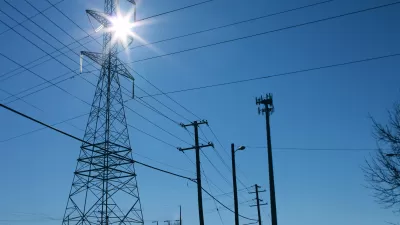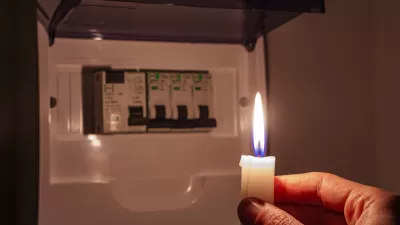Utilities profit from building more power plants—a flawed model for a diminishing natural monopoly.

David Roberts argues that New York State's Reforming the Energy Vision (REV) may be "the most important clean energy policy initiative in the country today." Not only can it change a poorly aligned incentive structure but also will contribute to national carbon reduction targets, setting an example for the rest of the country.
"Reforming utilities is a perilous process, with intense politics and high stakes. Reliable service must be maintained throughout any transition — it's like rebuilding an airplane in flight," Roberts warns. There remain many uncertainties about how and whether or not it will work, but he opines that New York's innovative vision is a clear path to real reform.
The REV will tackle grid inefficiencies by smoothing out the load profile - reducing congestion at peak energy hours. "To do that, it needs to encourage energy efficiency, demand shifting, and distributed energy resources (DER)s — all of which, in the traditional regulatory model, reduce utility revenue." This is because utilities make money by building more power plants—not by improving efficiency of existing plants.
To fill the gap in revenues from reduced capital expenditures, the REV proposes that utilities are restructured to be distributed service providers (DSPs), responsible for maintaining the grid but also involved in creating and managing “markets where third parties can compete to provide energy products and services on the retail side, things like energy storage, demand response, and distributed generation,” Roberts explains.
"The boundary of the [public utility's] natural monopoly has moved inward again. What remains of it is grid operations and reliability planning — that is, running the distribution grid itself. That's the only function that is still properly the purview of a publicly accountable, regulated utility."
FULL STORY: New York's revolutionary plan to remake its power utilities

Planetizen Federal Action Tracker
A weekly monitor of how Trump’s orders and actions are impacting planners and planning in America.

USGS Water Science Centers Targeted for Closure
If their work is suspended, states could lose a valuable resource for monitoring, understanding, and managing water resources.

Congress Moves to End Reconnecting Communities and Related Grants
The House Transportation and Infrastructure Committee moved to rescind funding for the Neighborhood Equity and Access program, which funds highway removals, freeway caps, transit projects, pedestrian infrastructure, and more.

Poor Conditions in Mobile Home Parks Put Residents at Risk
Failing infrastructure, poor water and air quality, and predatory owners endanger the health of manufactured home residents, many of whom are elderly and low-income.

How Complete Streets Stands to Lose in the FY26 ‘Skinny Budget’
The President’s proposed budget could cut key resources for active transportation, public transit, and road safety programs.

Dairy Queen and Rural Third Places
Dozens of Dairy Queen restaurants across Texas are closing, taking a critical community space with them.
Urban Design for Planners 1: Software Tools
This six-course series explores essential urban design concepts using open source software and equips planners with the tools they need to participate fully in the urban design process.
Planning for Universal Design
Learn the tools for implementing Universal Design in planning regulations.
City of Moorpark
City of Tustin
Tyler Technologies
City of Astoria
Transportation Research & Education Center (TREC) at Portland State University
Chaddick Institute at DePaul University
Regional Transportation Commission of Southern Nevada
Toledo-Lucas County Plan Commissions




























